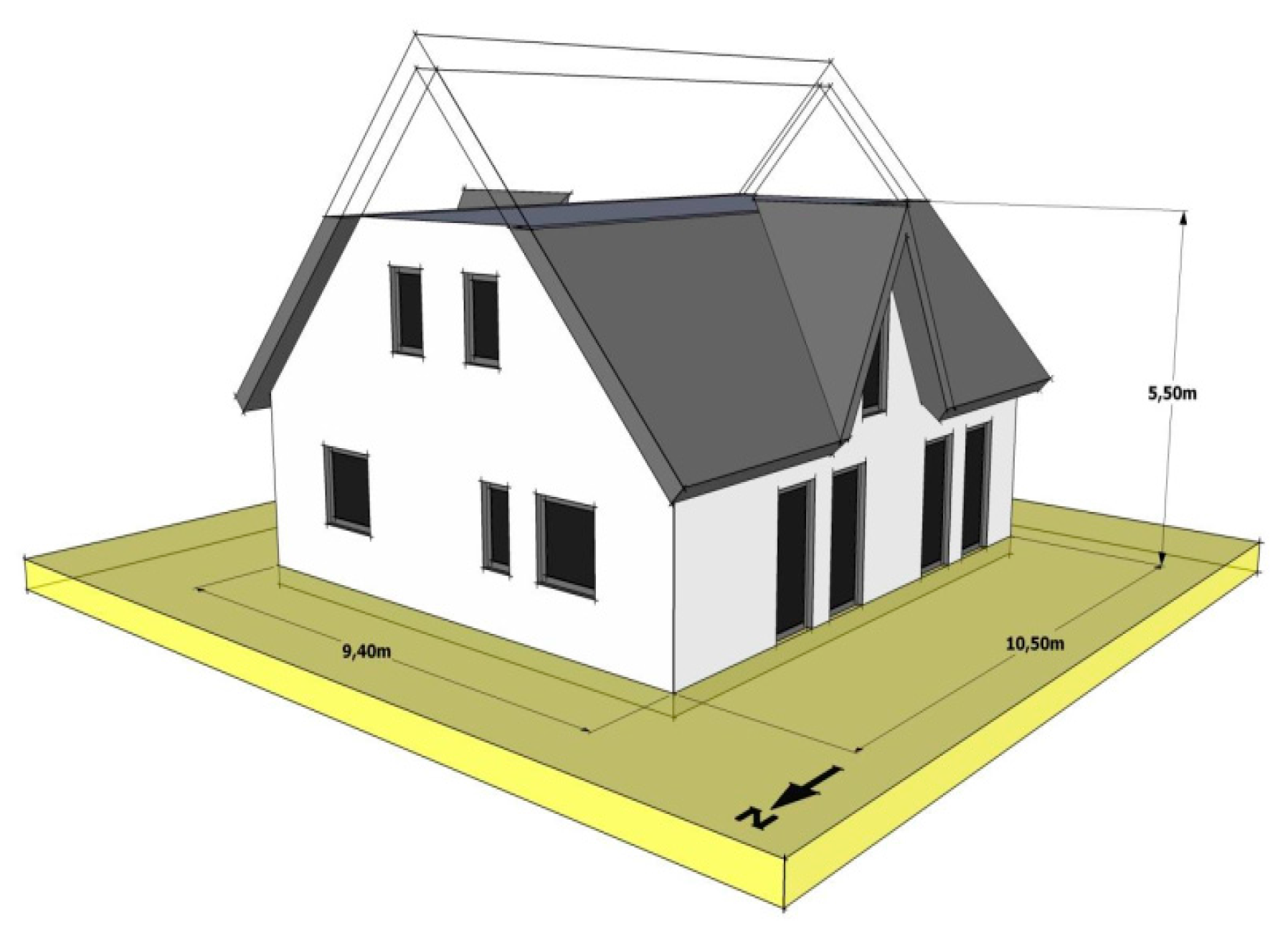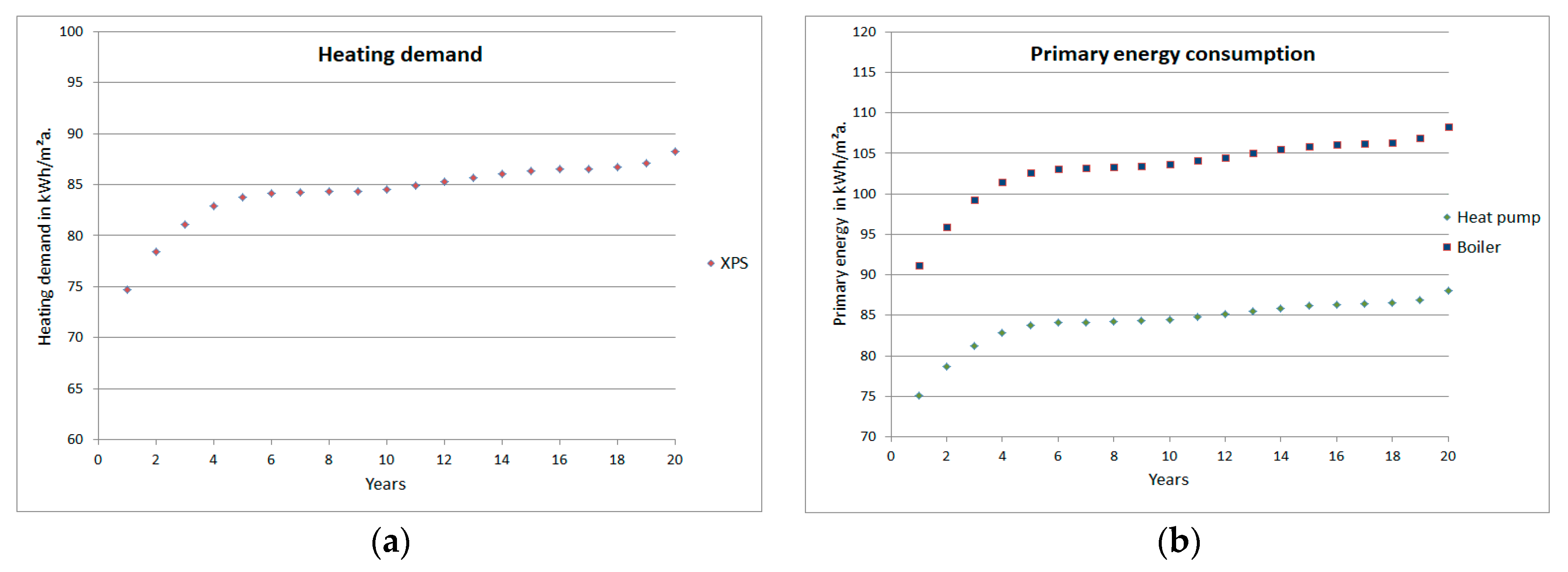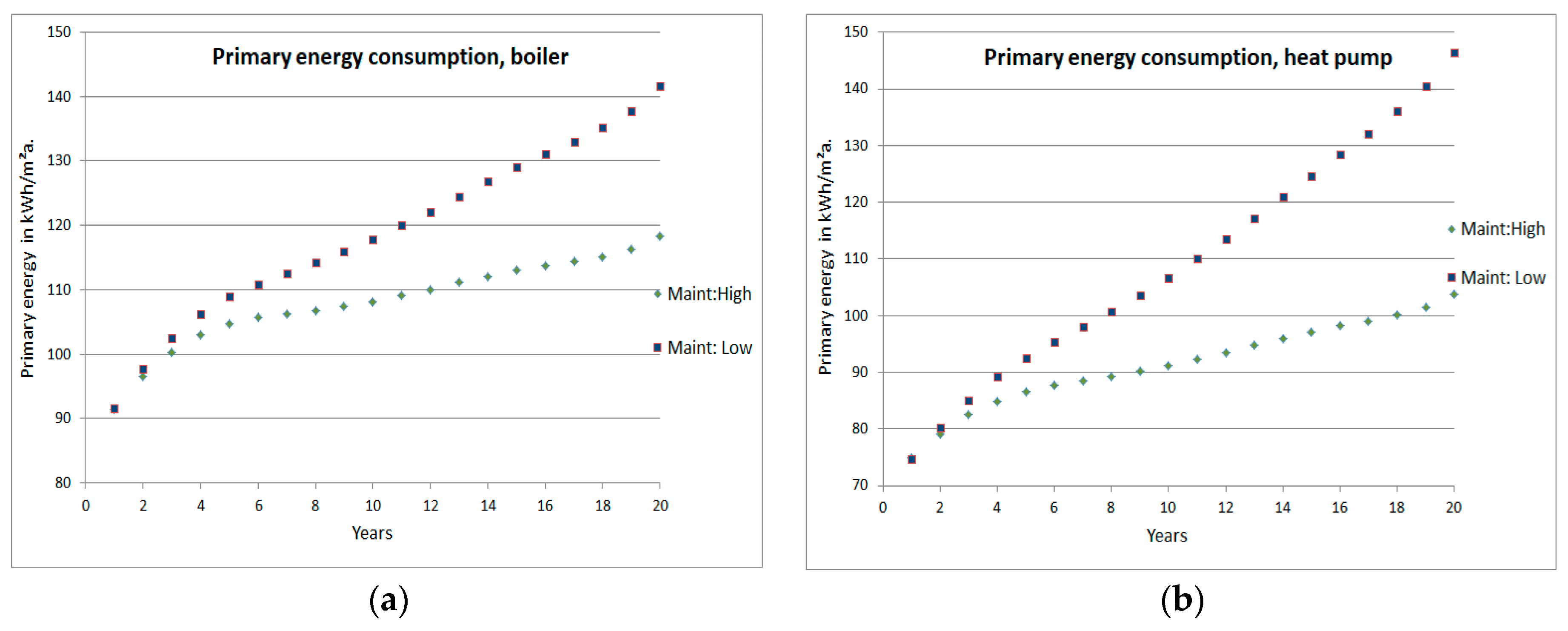1. Introduction
The building sector is responsible for approximately 40% of the total energy consumption in the European Union (EU) [
1]. Due to this fact, improving the energy performance of buildings is key in reaching the EU target of 20-20-20 (20% CO
2 emissions reduction, 20% increase in energy efficiency and 20% more energy from renewable sources until the year 2020 compared to the levels of 1990) [
2]. As a means of achieving this goal, the Energy Performance of Building Directive 2010/31/EU, (EPBD) recast [
3] obliges EU member states to evaluate their national requirements on the energy performance of buildings following the so-called “cost optimal methodology”. The methodology framework was published as EU supplementary EBPD recast in 2012 [
4] and, subsequently, the member states assessed their national requirements as of 30 June 2012 and submitted the respective reports [
5].
In Germany, the energy consultancy Ecofys evaluated the requirements of the German Energy Saving Ordinance that was active at that time (EnEV 2009) on behalf of the Federal Ministry of Transport, Building and Urban Development by applying the aforementioned methodology to various standard building types [
6]. Additionally, since the energy efficiency of buildings can be increased either by improving envelope thermal properties or by upgrading the technical equipment, different energy efficiency measures and measure packages were compared as part of this study.
However, the calculations according to EnEV do not completely depict reality. For that reason, applying building energy simulations can be a first step toward achieving higher accuracy. Nonetheless, there are various uncertainty sources that can influence the building performance assessment process. Some of these sources, such as the impact of climate change on future considerations [
7,
8] have already been examined to a satisfactory level. Still, there are others that are yet to be put under thorough examination, one of them being the ageing of buildings and their components.
The performance of both building envelope elements and energy supply systems deteriorates with time as a result of natural ageing, mismanagement and poor maintenance [
9]. This decline can best be defined as “performance degradation”. It leads to lower energy efficiency and higher life cycle costs than projected, since its effects are generally not being taken into consideration, neither by energy calculation norms nor by conventional simulation models or existing optimization concepts [
2,
10,
11].
The purpose of this paper is the simplified examination of the impact of performance degradation of selected components on the overall building energy performance. First, a short review on building performance degradation is carried out. Subsequently, the building considered for the case study (a single-family house in Germany) and the model used for simulating its energy performance are introduced. Finally, the way in which degradation is considered in the simulations is described, and the results of the predicted building energy performance are presented. The assessment of these results leads to first conclusions about the extent of the impact of degradation on the long-term energy performance of buildings.
2. Review of Building Performance Degradation
As mentioned, the impact of building ageing on its energy efficiency is generally neglected in current performance assessments. Nevertheless, some studies examine the influence of degradation on whole building thermal performance while also taking climate change into account [
9,
12]. De Wilde et al. [
12] use the open source building simulation software EnergyPlus V 5.0 to simulate the performance of a supermarket in Plymouth, UK, over 40 years, while the IDA ICE model is implemented by Waddicor et al. [
9] for the energy performance simulations of a library building in Turin, Italy, over 50 years. In a thesis by Magnuson, [
13] the impact of heating, ventilation, and air conditioning (HVAC) component degradation on two buildings of the University of Kansas in Lawrence, Kansas, USA, is examined. Here, as well as in [
9], simple deterministic models are applied for degradation consideration, whereas in [
12] both a deterministic and a stochastic method are used. Regardless of the used degradation models, these three studies conclude that building energy performance is very sensitive to its ageing and particularly to the degradation of mechanical components used for heating, ventilation, and air conditioning (HVAC).
The amount of reviewed studies is not sufficient for drawing definite conclusions on the impact of ageing on the whole building energy performance. Hence, a more thorough examination of the degradation of the single building elements is needed for predicting building long term performance. Even though there is limited amount of quantitative data available on the long-term performance of single building elements and mechanical components [
12], there are studies that deal with the degradation of some of them. An overview of such studies on HVAC systems and different insulation types can be found in [
14]. According to this article, the components for which the most reliable degradation values are available are boilers and heat pumps. As far as insulation is concerned, the ageing of extruded polystyrene (XPS), polyisocyanurate (PIR), polyurethane (PUR), and vacuum insulation panels (VIPs) has been reviewed to a satisfactory level.
Generally, HVAC performance deteriorates with time because of natural ageing and wear due to operation. This performance degradation is expressed by a drop in the Coefficient of Performance (COP) of an HVAC system. Struck et al. [
15] present a method for predicting the COP drop of HVAC systems over their lifetime. According to this study, long-term HVAC performance depends on part load performance and annual COP drop expressed by a degradation factor. Similar degradation factors that take maintenance quality into account are applied by the national renewable energy laboratory (NREL) of the US department of energy to equations predicting performance decline over time. These equations can be of either linear [
16] or exponential [
17] nature. Indeed, there are many causes of performance decline associated with inadequate maintenance, especially for heat pumps and chillers. These include fouling in the condenser tube [
18] as well as oil fouling on heat exchangers due to leaks from the compressor [
19]. Wang et al. [
20] quantify the effect of such issues and present the results on the simulated energy consumption of an office building in Chicago, USA. An additional cause of COP drop is the change in ground temperature in the case where ground is used as an energy source [
21].
The degradation of the building envelope elements comes as a result of the external and internal climate of the building. The external climate factors that impact the envelope include but are not limited to solar radiation, extreme temperatures, moisture, and pollution. The internal environment is dependent upon both the external climate and occupant behavior [
22]. The performance decline of insulation can best be quantified by conducting accelerated climate ageing tests in the laboratory. Singh et al. [
23] apply the simulation software Agesim in addition to such laboratory measurements in order to predict future performance of XPS and polyisocyanurate (PIR) boards. Results from this and other studies show that the largest amount of performance degradation of most insulation elements occurs during the first two years after installation.
The different degradation characteristics of three vaccum insulation panel (VIP) barrier envelope types after subjection to high temperature, alkali, and stress concentration were investigated by Li et al. [
24]. Their main conclusion was that the combination of increased temperature and alkalinity leads to the highest degradation rates. In an assessment of the performance of VIPs after five years of installation, Molletti et al. [
25] reported a degradation of 10%. As far as glass wool insulation is concerned, Stazi et al. [
26] carried out an experimental study on buildings constructed in the 1980s with a glass wool insulation layer in the envelope cavity. One key finding of this study was that the thermal conductivity has risen by 12% during the investigated time frame. Finally, Lakatos [
27] assessed the impact of moisture accumulation on aerogel blankets and found out that the thermal resistance of insulation elements decreases by at least 20% if they contain at least 20% moisture and that wall surface heat transfer coefficient changes with 1 W/m
2∙K if 0.28 kg of water are sprayed on it.
4. Results
As a first step, the impact of the performance decline of single elements on building energy consumption for heating, DHW and ventilation over 20 years is examined. The effect of insulation thermal conductivity rise is shown in
Figure 2, while the results of the efficiency drop of boiler and heat pump for the two different maintenance scenarios are presented in
Figure 3.
In
Table 7, an overview of the key results regarding single building element degradation is provided. It is worth noting that the building can consume up to 29.7% more primary energy than expected over the life cycle of 20 years, if air-source heat pump is the central heating component and it is not maintained properly. Additionally, the energy savings of the heat pump system compared to the boiler system are nullified after 20 years in the case that both components undergo poor maintenance.
The combined effects of insulation and heat supply system degradation are evaluated next. As expected, the building energy performance deterioration with time is considerably higher in this case. The effect of envelope degradation is more dominant during the first three years, as can be concluded by the fact that maintenance quality does not play a major role in energy performance in this time frame. For the next 10 years, the rise in energy consumption is almost linear, since the envelope degradation rate diminishes while HVAC degradation is increased, whereas in the last year of operation, the high impact of mechanical degradation is evident through the exponential energy consumption increase. The projected primary energy consumption for all four assessed scenarios is depicted in
Figure 4.
The key findings regarding the combined impact of insulation, boiler and heat pump degradation on overall building performance are shown in
Table 8. Even if the central heating component of the building is a professionally maintained boiler, the total primary energy consumed over 20 years is at least 18.4 % higher than the projected value without degradation. For a poorly maintained heat pump, this value lies at 47.1%. This means that in such a case the building consumes in a time interval of 20 years the primary energy it would consume in 29 years and four months if no degradation occurred. An additional value that stands out in this scenario is the primary energy consumption in the 20th year, which is almost twice as high (+96.2%) as its expected value, if its coefficient of performance remained stable.
5. Conclusions
In this article, the impact of performance degradation of XPS insulation, gas boilers, and air-source heat pumps on the long-term building energy performance is examined through simulation of different scenarios. Due to the limited amount of quantitative data, simplified degradation equations have to be introduced to project the future performance of the mentioned elements. The application of these degradation models leads to a significant rise in building energy consumption with time. In the case where single component degradation is considered, the additional primary consumption over the course of 20 years is 4.4–29.7 % higher than in a scenario without degradation, while the combined effects of component ageing lead to values between 18.4% and 47.1%. Thus, it is evident that performance degradation is a significant factor that has to be taken into account for energy performance assessments in the early design phase of a building.
HVAC component performance is very susceptible to decline due to ageing. Highly complex systems, such as the assessed air-source heat pump, are set to perform considerably worse than expected if they are not maintained properly, with energy consumption after 20 years reaching values that are almost twice as high as the initial ones. For that reason, proper annual maintenance is crucial for moderating the consequences of performance deterioration due to natural ageing and mechanical wear.
The demonstration of the significance of taking performance degradation into account is possible even with the low amount of components and the high degree of simplification that are characteristic of this paper. Nonetheless, it should be expected that the real extent of building performance decline due to component ageing and malfunction is considerably higher. Due to the limited amount of data available, more accurate quantification of the long-term performance of a wider range of components is required. This would principally require extensive building performance monitoring and data acquisition. Additionally, since it is highly unrealistic to claim that degradation occurs solely due to ageing and poor maintenance and that its values consequently follow predefined functions of time, a closer look has to be taken into each building element. The wider usage of simulation tools that emulate component behavior that leads to a higher wear, such as the constant switching on and off of heat pumps, can be a useful means of achieving that. Only through taking such steps to improve the predictability of long term energy performance will it be possible to reach the required maximum accuracy when designing future-proof energy-efficient buildings.









